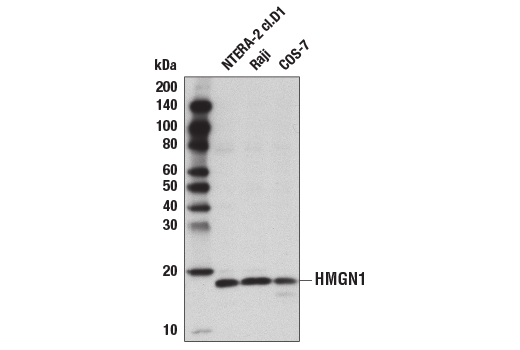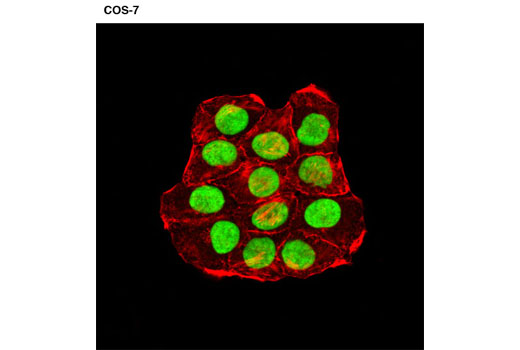WB, IF-IC
H Mk
Endogenous
18
Rabbit
#P05114
3150
Product Information
Product Usage Information
| Application | Dilution |
|---|---|
| Western Blotting | 1:1000 |
| Immunofluorescence (Immunocytochemistry) | 1:800 - 1:1600 |
Storage
Specificity / Sensitivity
Species Reactivity:
Human, Monkey
Species predicted to react based on 100% sequence homology
The antigen sequence used to produce this antibody shares
100% sequence homology with the species listed here, but
reactivity has not been tested or confirmed to work by CST.
Use of this product with these species is not covered under
our
Product Performance Guarantee.
Bovine
Source / Purification
Polyclonal antibodies are produced by immunizing animals with a synthetic peptide corresponding to residues surrounding Val65 of human HMGN1 protein. Antibodies are purified by protein A and peptide affinity chromatography.
Background
High mobility group (HMG) proteins are a superfamily of abundant and ubiquitous nuclear proteins that bind DNA without sequence specificity and induce structural changes to the chromatin fiber to regulate access to the underlying DNA. The HMGN family of proteins, which includes five members (HMGN1-5), is characterized by the presence of several conserved protein domains: a positively charged domain, a nucleosome binding domain, and an acidic C-terminal chromatin-unfolding domain (1,2). HMGN proteins function in transcriptional regulation and are recruited to gene promoters by transcription factors, such as estrogen receptor α (ERα), serum responsive factor (SRF), and PITX2, where they can facilitate either gene activation or repression (3-5). HMGN proteins bind specifically to nucleosomal DNA and reduce compaction of the chromatin fiber, in part by competing with linker histone H1 for nucleosome binding (6). In addition, HMGN proteins act to modulate local levels of post-translational histone modifications, decreasing phosphorylation of histone H3 at Ser10 and histone H2A at Ser1 and increasing acetylation of histone H3 at Lys14 (7-9). HMGN proteins can also modulate the activity of several chromatin-remodeling factors and restrict nucleosome mobility (10).
HMGN1 (also known as HMG14) expression is tightly linked to cellular differentiation. HMGN1 is ubiquitous and highly expressed in all embryonic tissues. During mouse embryogenesis, expression is down-regulated throughout the embryo, except in committed but continuously renewing cell types undergoing active differentiation, such as the basal layer of the epithelium and kidney cells undergoing mesenchyme to epithelium transition (11,12). HMGN1 expression is also down-regulated during myogenesis, erythropoiesis, and osteogenesis (11). Over-expression of HMGN1 inhibits myotube formation in C2C12 myoblast cells and chondrocyte differentiation in primary limb bud mesenchymal cells, suggesting a role in blocking cellular differentiation (11,13). HGMN1-/- mice appear normal, most likely due to partial redundancy with other family members such as HMGN2. However, these mice are hypersensitive to various stress conditions, including exposure to UV light and ionizing radiation (IR) (14,15). Further studies have shown that HMGN1 is required for efficient transcription-coupled repair (TCR) following UV treatment, and proper activation of ATM following IR treatment, both of which require HMGN1 chromatin binding activity, suggesting a direct role for HMGN1 in chromatin remodeling during DNA repair (14-17).
- Hock, R. et al. (2007) Trends Cell Biol 17, 72-9.
- Gerlitz, G. Biochim Biophys Acta 1799, 80-5.
- Zhu, N. and Hansen, U. (2007) Mol Cell Biol 27, 8859-73.
- Amen, M. et al. (2008) Nucleic Acids Res 36, 462-76.
- Belova, G.I. et al. (2008) J Biol Chem 283, 8080-8.
- Catez, F. et al. (2002) EMBO Rep 3, 760-6.
- Lim, J.H. et al. (2005) EMBO J 24, 3038-48.
- Lim, J.H. et al. (2004) Mol Cell 15, 573-84.
- Postnikov, Y.V. et al. (2006) Biochemistry 45, 15092-9.
- Rattner, B.P. et al. (2009) Mol Cell 34, 620-6.
- Furusawa, T. et al. (2006) Mol Cell Biol 26, 592-604.
- Lehtonen, S. and Lehtonen, E. (2001) Differentiation 67, 154-63.
- Pash, J.M. et al. (1993) J Biol Chem 268, 13632-8.
- Birger, Y. et al. (2003) EMBO J 22, 1665-75.
- Birger, Y. et al. (2005) Cancer Res 65, 6711-8.
- Fousteri, M. et al. (2006) Mol Cell 23, 471-82.
- Kim, Y.C. et al. (2009) Nat Cell Biol 11, 92-6.
Species Reactivity
Species reactivity is determined by testing in at least one approved application (e.g., western blot).
Western Blot Buffer
IMPORTANT: For western blots, incubate membrane with diluted primary antibody in 5% w/v BSA, 1X TBS, 0.1% Tween® 20 at 4°C with gentle shaking, overnight.
Applications Key
WB: Western Blotting IF-IC: Immunofluorescence (Immunocytochemistry)
Cross-Reactivity Key
H: human M: mouse R: rat Hm: hamster Mk: monkey Vir: virus Mi: mink C: chicken Dm: D. melanogaster X: Xenopus Z: zebrafish B: bovine Dg: dog Pg: pig Sc: S. cerevisiae Ce: C. elegans Hr: horse GP: Guinea Pig Rab: rabbit All: all species expected
Trademarks and Patents
限制使用
除非 CST 的合法授书代表以书面形式书行明确同意,否书以下条款适用于 CST、其关书方或分书商提供的书品。 任何书充本条款或与本条款不同的客书条款和条件,除非书 CST 的合法授书代表以书面形式书独接受, 否书均被拒书,并且无效。
专品专有“专供研究使用”的专专或专似的专专声明, 且未专得美国食品和专品管理局或其他外国或国内专管机专专专任何用途的批准、准专或专可。客专不得将任何专品用于任何专断或治专目的, 或以任何不符合专专声明的方式使用专品。CST 专售或专可的专品提供专作专最专用专的客专,且专用于研专用途。将专品用于专断、专防或治专目的, 或专专售(专独或作专专成)或其他商专目的而专专专品,均需要 CST 的专独专可。客专:(a) 不得专独或与其他材料专合向任何第三方出售、专可、 出借、捐专或以其他方式专专或提供任何专品,或使用专品制造任何商专专品,(b) 不得复制、修改、逆向工程、反专专、 反专专专品或以其他方式专专专专专品的基专专专或技专,或使用专品开专任何与 CST 的专品或服专专争的专品或服专, (c) 不得更改或专除专品上的任何商专、商品名称、徽专、专利或版专声明或专专,(d) 只能根据 CST 的专品专售条款和任何适用文档使用专品, (e) 专遵守客专与专品一起使用的任何第三方专品或服专的任何专可、服专条款或专似专专

